Evaluation of 32 Simple Equations against the Penman–Monteith Method to Estimate the Reference Evapotranspiration in the Hexi Corridor, Northwest China
Abstract
1. Introduction
2. Study Area, Materials and Methods
2.1. Geography and Climate of the Hexi Corridor
2.2. Data and Source of Materials
3. Methods and Methodology
3.1. Penman–Monteith Method
3.2. Simple ET0 Equations
3.3. Model Evaluation, Selection, and Calibration
4. Results and Discussions
4.1. Performance of the Simple ET0 Models
4.2. Cross-Comparison of the ET0 Models
4.3. Calibration of the ET0 Models
5. Conclusions
Supplementary Materials
Author Contributions
Funding
Conflicts of Interest
References
- Ndiaye, P.M.; Bodian, A.; Diop, L.; Deme, A.; Dezetter, A.; Djaman, K. Evaluation and Calibration of Alternative Methods for Estimating Reference Evapotranspiration in the Senegal River Basin. Hydrology 2020, 7, 24. [Google Scholar] [CrossRef]
- Zhao, L.; Xia, J.; Xu, C.Y.; Wang, Z.; Sobkowiak, L.; Long, C. Evapotranspiration estimation methods in hydrological models. J. Geogr. Sci. 2013, 23, 359–369. [Google Scholar] [CrossRef]
- Bandyopadhyay, A.; Bhadra, A.; Swarnakar, R.K.; Raghuwanshi, N.S.; Singh, R. Estimation of reference evapotranspiration using a user-friendly decision support system: DSS_ET. Agric. For. Meteorol. 2012, 154–155, 19–29. [Google Scholar] [CrossRef]
- Djaman, K.; O’Neill, M.; Diop, L.; Bodian, A.; Allen, S.; Koudahe, K.; Lombard, K. Evaluation of the penman-monteith and other 34 reference evapotranspiration equations under limited data in a semiarid dry climate. Theor. Appl. Climatol. 2019, 137, 729–743. [Google Scholar] [CrossRef]
- Sharma, M.L. Estimating Evapotranspiration. In Advances in Irrigation; Hillel, D., Ed.; Academic Press: New York, NY, USA, 1985; pp. 213–281. ISBN 0275-7915. [Google Scholar]
- Berti, A.; Tardivo, G.; Chiaudani, A.; Rech, F.; Borin, M. Assessing reference evapotranspiration by the Hargreaves method in North-Eastern Italy. Agric. Water Manag. 2014, 140, 20–25. [Google Scholar] [CrossRef]
- Ahooghalandari, M.; Khiadani, M.; Jahromi, M.E. Developing equations for estimating reference evapotranspiration in Australia. Water Resour. Manag. 2016, 30, 3815–3828. [Google Scholar] [CrossRef]
- Ahooghalandari, M.; Khiadani, M.; Jahromi, M.E. Calibration of Valiantzas’ reference evapotranspiration equations for the Pilbara region, Western Australia. Theor. Appl. Climatol. 2017, 128, 845–856. [Google Scholar] [CrossRef]
- Quej, V.H.; Martí, P. Global performance ranking of temperature-based approaches for evapotranspiration estimation considering Köppen climate classes. J. Hydrol. 2015, 528, 514–522. [Google Scholar] [CrossRef]
- Priestley, C.H.B.; Taylor, R.J. On the assessment of surface heat flux and evaporation using large-scale parameters. Mon. Weather Rev. 1972, 100, 81–92. [Google Scholar] [CrossRef]
- Trajkovic, S. Temperature-based approaches for estimating reference evapotranspiration. J. Irrig. Drain Eng. 2005, 131, 316–323. [Google Scholar] [CrossRef]
- Allen, R.G.; Pereira, L.S.; Raes, D.; Smith, M. Crop evapotranspiration: Guidelines for computing crop water requirements. FAO Irrig. Drain. Pap. 1998, 56, 300. [Google Scholar]
- Allen, R.G.; Clemmens, A.J.; Burt, C.M.; Solomon, K.; O’Halloran, T. Prediction accuracy for projectwide evapotranspiration using crop coefficients and reference evapotranspiration. J. Irrig. Drain Eng. 2005, 131, 24–36. [Google Scholar] [CrossRef]
- Allen, R.G.; Pruitt, W.O.; Wright, J.L.; Howell, T.A.; Ventura, F.; Snyder, R.; Itenfisu, D.; Steduto, P.; Berengena, J.; Yrisarry, J.B.; et al. A recommendation on standardized surface resistance for hourly calculation of reference ETo by the FAO56 penman-monteith method. Agric. Water Manag. 2006, 81, 1–22. [Google Scholar] [CrossRef]
- Sahli, A. Evaluation of FAO-56 methodology for estimating reference evapotranspiration using limited climatic data application to Tunisia. Agric. Water Manag. 2008, 95, 707–715. [Google Scholar] [CrossRef]
- Berengena, J.; Allen, R.G. Measuring versus estimating net radiation and soil heat flux: Impact on penman–monteith reference ET estimates in semiarid regions. Agric. Water Manag. 2007, 89, 275–286. [Google Scholar] [CrossRef]
- Pizza, S.; Caponio, T.; Rivelli, A.R.; Perniola, M. Lysimetric determination of muskmelon crop coefficients cultivated under plastic mulches. Agric. Water Manag. 2005, 72, 147–159. [Google Scholar] [CrossRef]
- Tabari, H.; Talaee, P.H. Local calibration of the hargreaves and priestley-taylor equations for estimating reference evapotranspiration in arid and cold climates of iran based on the penman-monteith model. J. Hydrol. Eng. 2011, 16, 837–845. [Google Scholar] [CrossRef]
- Dorji, U.; Olesen, J.E.; Seidenkrantz, M.S. Water balance in the complex mountainous terrain of Bhutan and linkages to land use. J. Hydrol. Reg. Stud. 2016, 7, 55–68. [Google Scholar] [CrossRef]
- Droogers, P.; Allen, R.G. Estimating reference evapotranspiration under inaccurate data conditions. Irrig. Drain. Syst. 2002, 16, 33–45. [Google Scholar] [CrossRef]
- Trajkovic, S. Hargreaves versus penman-monteith under humid conditions. J. Irrig. Drain. Eng. 2007, 133, 38–42. [Google Scholar] [CrossRef]
- Hargreaves, G.; Allen, R. History and evaluation of hargreaves evapotranspiration equation. J. Irrig. Drain. Eng. 2003, 129, 53–63. [Google Scholar] [CrossRef]
- Heydari, M.M.; Heydari, M. Calibration of hargreaves–Samani equation for estimating reference evapotranspiration in semiarid and arid regions. Arch. Fèur Acker Pflanzenbau Bodenkd. 2014, 60, 695–713. [Google Scholar] [CrossRef]
- Gafurov, Z.; Eltazarov, S.; Akramov, B.; Yuldashev, T.; Djumaboev, K.; Anarbekov, O. Modifying hargreaves-samani equation for estimating reference evapotranspiration in dryland regions of Amudarya River Basin. Agric. Sci. 2018, 9, 1354–1368. [Google Scholar] [CrossRef]
- Amatya, D.M.; Skaggs, R.W.; Gregory, J.D. Comparison of methods for estimating REF-ET. J. Irrig. Drain. Eng. 1995, 121, 427–435. [Google Scholar] [CrossRef]
- Feng, Y.; Jia, Y.; Cui, N.; Zhao, L.; Li, C.; Gong, D. Calibration of Hargreaves model for reference evapotranspiration estimation in Sichuan basin of southwest China. Agric. Water Manag. 2017, 181, 1–9. [Google Scholar] [CrossRef]
- Lima, J.R.D.S.; Antonino, A.C.D.; Souza, E.S.D.; Hammecker, C.; Montenegro, S.M.G.L.; Lira, C.A.B.D.O. Calibration of hargreaves-samani equation for estimating reference evapotranspiration in Sub-Humid region of Brazil. J. Water Reour. Prot. 2013, 5, 1–5. [Google Scholar] [CrossRef]
- Mehdizadeh, S.; Saadatnejadgharahassanlou, H.; Behmanesh, J. Calibration of hargreaves–samani and priestley–taylor equations in estimating reference evapotranspiration in the Northwest of Iran. Arch. Fèur Acker Pflanzenbau Bodenkd. 2017, 63, 942–955. [Google Scholar] [CrossRef]
- Pereira, L.S. Estimation of ETo with hargreaves–samani and FAO-PM temperature methods for a wide range of climates in Iran. Agric. Water Manag. 2013, 121, 1–18. [Google Scholar] [CrossRef]
- Rahimi Khoob, A. Comparative study of Hargreaves’s and artificial neural network’s methodologies in estimating reference evapotranspiration in a semiarid environment. Irrig. Sci. 2008, 26, 253–259. [Google Scholar] [CrossRef]
- Gao, F.; Feng, G.; Ouyang, Y.; Wang, H.; Fisher, D.; Adeli, A.; Jenkins, J. Evaluation of Reference Evapotranspiration Methods in Arid, Semiarid, and Humid Regions. J. Am. Water Resour. Assoc. 2017, 53, 791–808. [Google Scholar] [CrossRef]
- Ahmed, H.I.; Liu, J. Evaluating reference crop evapotranspiration (ETo) in the centre of guanzhong basin—Case of Xingping & Wugong, Shaanxi, China. Engineering 2013, 5, 459–468. [Google Scholar] [CrossRef]
- Wenhuan, B.; Yawei, L.; Haiyu, W.; Shihong, Y.; Zheng, W. Modeling rice development and field water balance using AquaCrop model under drying-wetting cycle condition in eastern China. Agric. Water Manag. 2019, 213, 289–297. [Google Scholar] [CrossRef]
- Bourque, C.P.A. Assessing spatiotemporal variation in actual evapotranspiration for semi-arid watersheds in northwest China: Evaluation of two complementary-based methods. J. Hydrol. 2013, 486, 455–465. [Google Scholar] [CrossRef]
- Cui, N.; Zhao, L.; Hu, X.; Gong, D. Comparison of ELM, GANN, WNN and empirical models for estimating reference evapotranspiration in humid region of Southwest China. J. Hydrol. 2016, 536, 376–383. [Google Scholar] [CrossRef]
- Erda, L. Performance of the priestley–Taylor equation in the semiarid climate of North China. Agric. Water Manag. 2005, 71, 1–17. [Google Scholar] [CrossRef]
- Gao, X.; Peng, S.; Xu, J.; Shihong, Y.; Wang, W. Proper methods and its calibration for estimating reference evapotranspiration using limited climatic data in Southwestern China. Arch. Fèur Acker Pflanzenbau Bodenkd. 2015, 61, 415–426. [Google Scholar] [CrossRef]
- Luo, Y.; Conglin, W.; Hezhen, Z.; Lei, Z.; Yuanlai, C.; Ningning, S.; Wang, L. Evaluation of six equations for daily reference evapotranspiration estimating using public weather forecast message for different climate regions across China. Agric. Water Manag. 2019, 222, 386–399. [Google Scholar] [CrossRef]
- Peng, L.; Li, Y.; Feng, H. The best alternative for estimating reference crop evapotranspiration in different sub-regions of mainland China. Sci. Rep. 2017, 7, 5458. [Google Scholar] [CrossRef]
- Song, X.; Lu, F.; Xiao, W.; Zhu, K.; Zhou, Y.; Xie, Z. Performance of 12 reference evapotranspiration estimation methods compared with the penman-monteith method and the potential influences in northeast China. Meteorol. Appl. 2019, 26, 83–96. [Google Scholar] [CrossRef]
- Wu, S.; Zheng, D.; Yang, Q. Radiation calibration of FAO56 penman–Monteith model to estimate reference crop evapotranspiration in China. Agric. Water Manag. 2008, 95, 77–84. [Google Scholar] [CrossRef]
- Valiantzas, J.D. Simplified limited data penman’s ET0 formulas adapted for humid locations. J. Hydrol. 2015, 524, 701–707. [Google Scholar] [CrossRef]
- Romanenko, V.A. Computation of the autumn soil moisture using a universal relationship for a large area. Proc. Ukr. Hydrometeorol. Res. Inst. 1961, 3, 12–25. [Google Scholar]
- Makkink, G.F. Testing the penman formula by means of lysimeters. J. Inst. Water Eng. 1957, 11, 277–288. [Google Scholar]
- Turk, L. Estimation of irrigation water requirements, potential evapotranspiration: A simple climatic formula evolved up to date. Ann. Agron. 1961, 12, 13–14. [Google Scholar]
- Valiantzas, J.D. Simplified versions for the penman evaporation equation using routine weather data. J. Hydrol. 2006, 331, 690–702. [Google Scholar] [CrossRef]
- Deng, Y.; Gou, X.; Gao, L.; Yang, M.; Zhang, F. Tree-ring recorded moisture variations over the past millennium in the Hexi Corridor, northwest China. Environ. Earth Sci. 2017, 76, 272. [Google Scholar] [CrossRef]
- Fang, C.L. Water resources constraint force on urbanization in water deficient regions: A case study of the Hexi Corridor, arid area of NW China. Ecol. Econ. 2007, 62, 508–517. [Google Scholar] [CrossRef]
- Tong, L.; Niu, J.; Kang, S.; Du, T.; Li, S.; Ding, R. Spatio-temporal distribution of irrigation water productivity and its driving factors for cereal crops in Hexi Corridor, Northwest China. Agric. Water Manag. 2017, 179, 55–63. [Google Scholar] [CrossRef]
- Wu, G.; Pan, B.; Guan, Q.; Liu, Z.; Li, J. Loess record of climatic changes during MIS5 in the Hexi Corridor, northwest China. Quat. Int. 2002, 97–98, 167–172. [Google Scholar] [CrossRef]
- Dodson, J.R.; Li, X.; Zhou, X.; Zhao, K.; Sun, N.; Atahan, P. Origin and spread of wheat in China. Quat. Sci. Rev. 2013, 72, 108–111. [Google Scholar] [CrossRef]
- Fu, J.; Niu, J.; Kang, S.; Adeloye, A.J.; Du, T. Crop production in the hexi corridor challenged by future climate change. J. Hydrol. 2019, 579. [Google Scholar] [CrossRef]
- Li, X.; Zhang, X.; Niu, J.; Tong, L.; Kang, S.; Du, T.; Li, S.; Ding, R. Irrigation water productivity is more influenced by agronomic practice factors than by climatic factors in Hexi Corridor, Northwest China. Sci. Rep. 2016, 6, 37971. [Google Scholar] [CrossRef] [PubMed]
- Hargreaves, H.G.; Samani, A.Z. Reference crop evapotranspiration from temperature. Appl. Eng. Agric. 1985, 1, 96–99. [Google Scholar] [CrossRef]
- Jensen, M.E.; Haise, H.R. Estimating evapotranspiration from solar radiation. Proc. Am. Soc. Civil Eng. 1963, 89, 15–41. [Google Scholar]
- Caprio, J. The Solar Thermal Unit Concept in Problems Related to Plant Development and Potential Evapotranspiration. In Phenology and Seasonality Modeling. Ecological Studies (Analysis and Synthesis); Lieth, H., Ed.; Springer: Berlin/Heidelberg, Germany; New York, NY, USA, 1974; ISBN 978-3-642-51865-2. [Google Scholar]
- George, H. Hargreaves. Moisture availability and crop production. Trans. ASABE 1975, 18, 980–984. [Google Scholar] [CrossRef]
- Abtew, W. Evapotranspiration measurements and modeling for three wetland systems in south Florida. J. Am. Water Resour. Assoc. 1996, 32, 465–473. [Google Scholar] [CrossRef]
- Irmak, S.A.; Allen, R.; Jones, A.J. Solar and net radiation-based equations to estimate reference evapotranspiration in humid climates. J. Irrig. Drain. Eng. 2003, 129, 336–347. [Google Scholar] [CrossRef]
- Rohwer, C. Evaporation from Free Water Surface; United States Department of Agriculture: Washington, DC, USA, 1931. [Google Scholar]
- Mahringer, W. Verdunstungsstudien am Neusiedler See. Theor. Appl. Climatol. 1970, 18, 1–20. [Google Scholar] [CrossRef]
- Dalton, J. Experimental essays on the constitution of mixed gases: On the force of steam or vapour from water and other liquids in different temperatures, both in a Torricellian vacuum and in air: On evaporation and on the expansion of gases. Mem. Lit. Philos. Soc. Manch. 1802, 5, 535–602. [Google Scholar]
- Xiang, K.; Li, Y.; Horton, R.; Feng, H. Similarity and difference of potential evapotranspiration and reference crop evapotranspiration—A review. Agric. Water Manag. 2020, 232, 106043. [Google Scholar] [CrossRef]
- Singh, V.P.; Xu, C.Y. Evaluation and Generalization of 13 equations for determining free water evaporation. Hydrol. Process. 1997, 11, 311–323. [Google Scholar] [CrossRef]
- Baier, W.; Robertson, G.W. Estimation of latent evaporation from simple weather observations. Can. J. Plant Sci. 1965, 45, 276–284. [Google Scholar] [CrossRef]
- Meyer, A. Ueber Einige Zusammenhänge Zwischen Klima und Boden in Europa; ETH: Zurich, Switzerland, 1926. [Google Scholar]
- Albrecht, F. Die methoden zur bestimmung der verdunstung der natürlichen erdoberfläche. Theor. Appl. Climatol. 1950, 2, 1–38. [Google Scholar] [CrossRef]
- WMO. Measurement and Estimation of Evaporation and Evapotranspiration. Technical Note No.83; Report of a Working Group on Evaporation Measurement of the Commission for Instrument and Methods of Observation; WMO: Geneva, Switzerland, 1966. [Google Scholar]
- Trabert, W. Neue beobachtungen über verdampfungsgeschwindigkeiten. Meteorol. Z. 1896, 13, 261–263. [Google Scholar]
- Brockamp, B.; Wenner, H. Verdunstungsmessungen auf den Steiner See bei Mu¨nster. Dt Gewässerkl. Mitt 1963, 7, 149–154. [Google Scholar]
- Penman, H.L. Vegetation and hydrology. Commonwealth bureau of soils, harpenden. Technical Communication No. 53; Commonwealth agricultural bureaux. Q.J.R. Meteorol. Soc. 1963, 89, 565–566. [Google Scholar] [CrossRef]
- Bos, M.G. Water Requirements for Irrigation and the Environment; Springer: Dordrecht, The Netherlands, 2009; ISBN 1402089481. [Google Scholar]
- Moriasi, D.N.; Arnold, J.G.; van Liew, W.M.; Bingner, R.L.; Harmel, R.D.; Veith, T.L. Model evaluation guidelines for systematic quantification of accuracy in watershed simulations. Trans. ASABE 2007, 50, 885–900. [Google Scholar] [CrossRef]
- Shiri, J. Improving the performance of the mass transfer-based reference evapotranspiration estimation approaches through a coupled wavelet-random forest methodology. J. Hydrol. 2018, 561, 737–750. [Google Scholar] [CrossRef]
- Shiri, J. Evaluation of FAO56-PM, empirical, semi-empirical and gene expression programming approaches for estimating daily reference evapotranspiration in hyper-arid regions of Iran. Agric. Water Manag. 2017, 188, 101–114. [Google Scholar] [CrossRef]
- Shiri, J.; Sadraddini, A.A.; Nazemi, A.H.; Marti, P.; Fakheri Fard, A.; Kisi, O.; Landeras, G. Independent testing for assessing the calibration of the Hargreaves–Samani equation New heuristic alternatives for Iran. Comput. Electron. Agric. 2015, 117, 70–80. [Google Scholar] [CrossRef]
- Valipour, M. Calibration of mass transfer-based models to predict reference crop evapotranspiration. Appl. Water Sci. 2017, 7, 625–635. [Google Scholar] [CrossRef]
- Didari, S.; Ahmadi, S.H. Calibration and evaluation of the FAO56-Penman-Monteith, FAO24-radiation, and Priestly-Taylor reference evapotranspiration models using the spatially measured solar radiation across a large arid and semi-arid area in southern Iran. Theor. Appl. Climatol. 2019, 136, 441–455. [Google Scholar] [CrossRef]
- Valiantzas, J.D. Temperature-and humidity-based simplified Penman’s ET0 formulae. Comparisons with temperature-based hargreaves-samani and other methodologies. Agric. Water Manag. 2018, 208, 326–334. [Google Scholar] [CrossRef]
- Xu, J.; Peng, S.; Ding, J.; Wei, Q.; Yu, Y. Evaluation and calibration of simple methods for daily reference evapotranspiration estimation in humid East China. Arc. Fèur Acker Pflanzenbau Bodenkd. 2013, 59, 845–858. [Google Scholar] [CrossRef]
- Maneta, M.P.; Schnabel, S.; Wallender, W.W.; Panday, S.; Jetten, V. Calibration of an evapotranspiration model to simulate soil water dynamics in a semiarid rangeland. Hydrol. Process. 2008, 22, 4655–4669. [Google Scholar] [CrossRef]
- Xu, Z.W.; Zuo, D.P.; Wang, X.M. Temporal variations of reference evapotranspiration and its sensitivity to meteorological factors in Heihe River Basin, China. Water Sci. Eng. 2015, 8, 1–8. [Google Scholar] [CrossRef][Green Version]
- Djaman, K.; Irmak, S.; Futakuchi, K. Daily Reference evapotranspiration estimation under limited data in Eastern Africa. J. Irrig. Drain. Eng. 2017, 143, 6016015. [Google Scholar] [CrossRef]
- Balde, A.B.; Sow, A.; Muller, B.; Irmak, S.; N’Diaye, M.K.; Baboucarr, M.; Moukoumbi, Y.D.; Futakuchi, K.; Saito, K. Evaluation of sixteen reference evapotranspiration methods under sahelian conditions in the Senegal River Valley. J. Hydrol. Reg. Stud. 2015, 3, 139–159. [Google Scholar] [CrossRef]
- Valipour, M. Application of new mass transfer formulae for computation of evapotranspiration. J. Appl. Water Eng. Res. 2014, 2, 33–46. [Google Scholar] [CrossRef]
- Djaman, K.; Tabari, H.; Balde Alpha, B.; Diop, L.; Futakuchi, K.; Irmak, S. Analyses, calibration and validation of evapotranspiration models to predict grass-reference evapotranspiration in the Senegal river delta. J. Hydrol. Reg. Stud. 2016, 8, 82–94. [Google Scholar] [CrossRef]
- Muhammad, M.; Nashwan, M.; Shahid, S.; Ismail, T.; Song, Y.; Chung, E.S. Evaluation of empirical reference evapotranspiration models using compromise programming: A case study of Peninsular Malaysia. Sustainability 2019, 11, 4267. [Google Scholar] [CrossRef]
- Li, M.; Chu, R.; Islam, A.R.M.T.; Shen, S. Reference evapotranspiration variation analysis and its approaches evaluation of 13 empirical models in sub-humid and humid regions a case study of the Huai River Basin, Eastern China. Water 2018, 10, 493. [Google Scholar] [CrossRef]
- Rahimikhoob, A.; Behbahani, M.R.; Fakheri, J. An evaluation of four reference evapotranspiration models in a subtropical climate. Water Resour. Manag. 2012, 26, 2867–2881. [Google Scholar] [CrossRef]
- Almorox, J.; Grieser, J. Calibration of the Hargreaves–Samani method for the calculation of reference evapotranspiration in different Köppen climate classes. Hydrol. Res. 2016, 47, 521–531. [Google Scholar] [CrossRef]
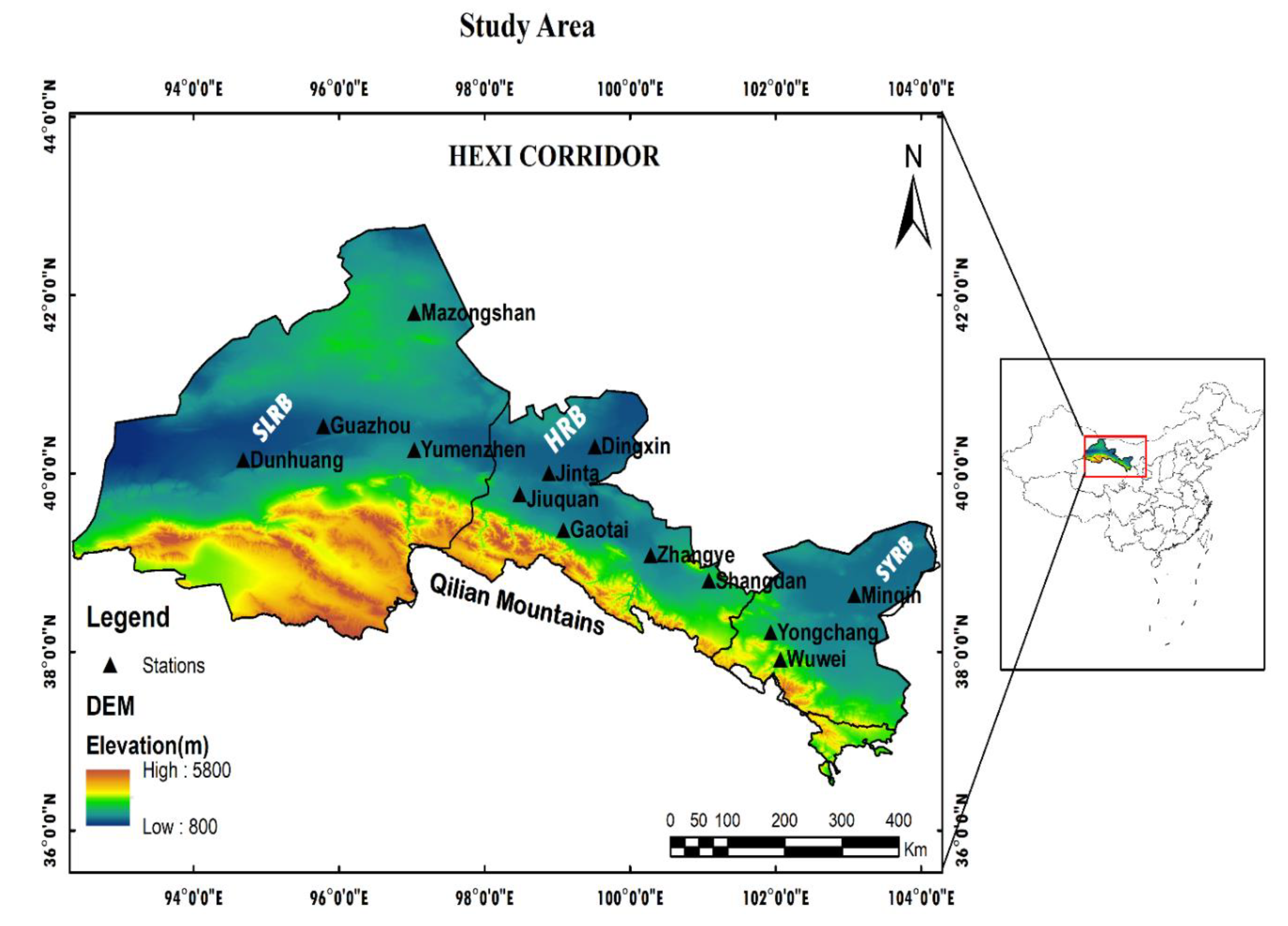
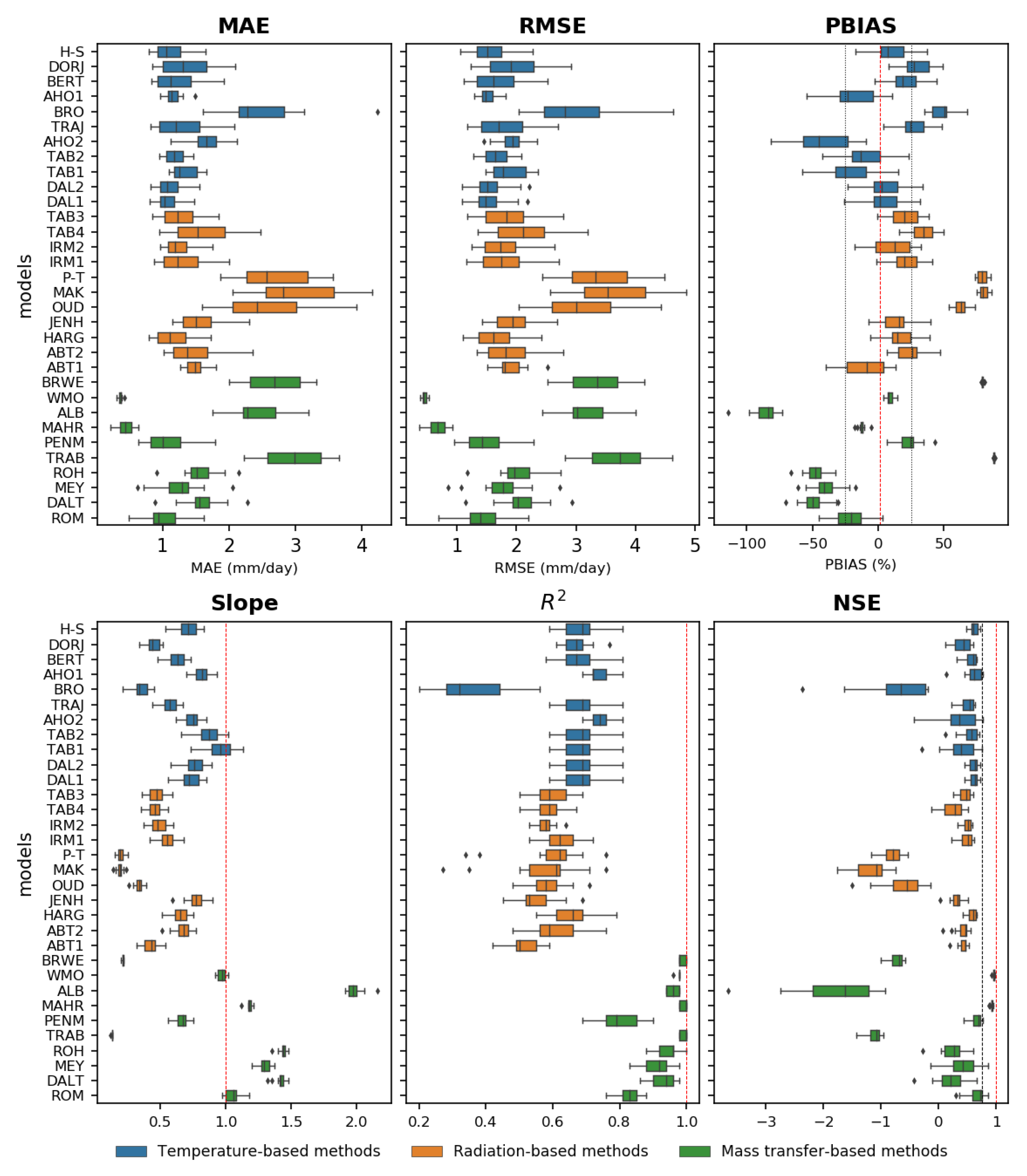
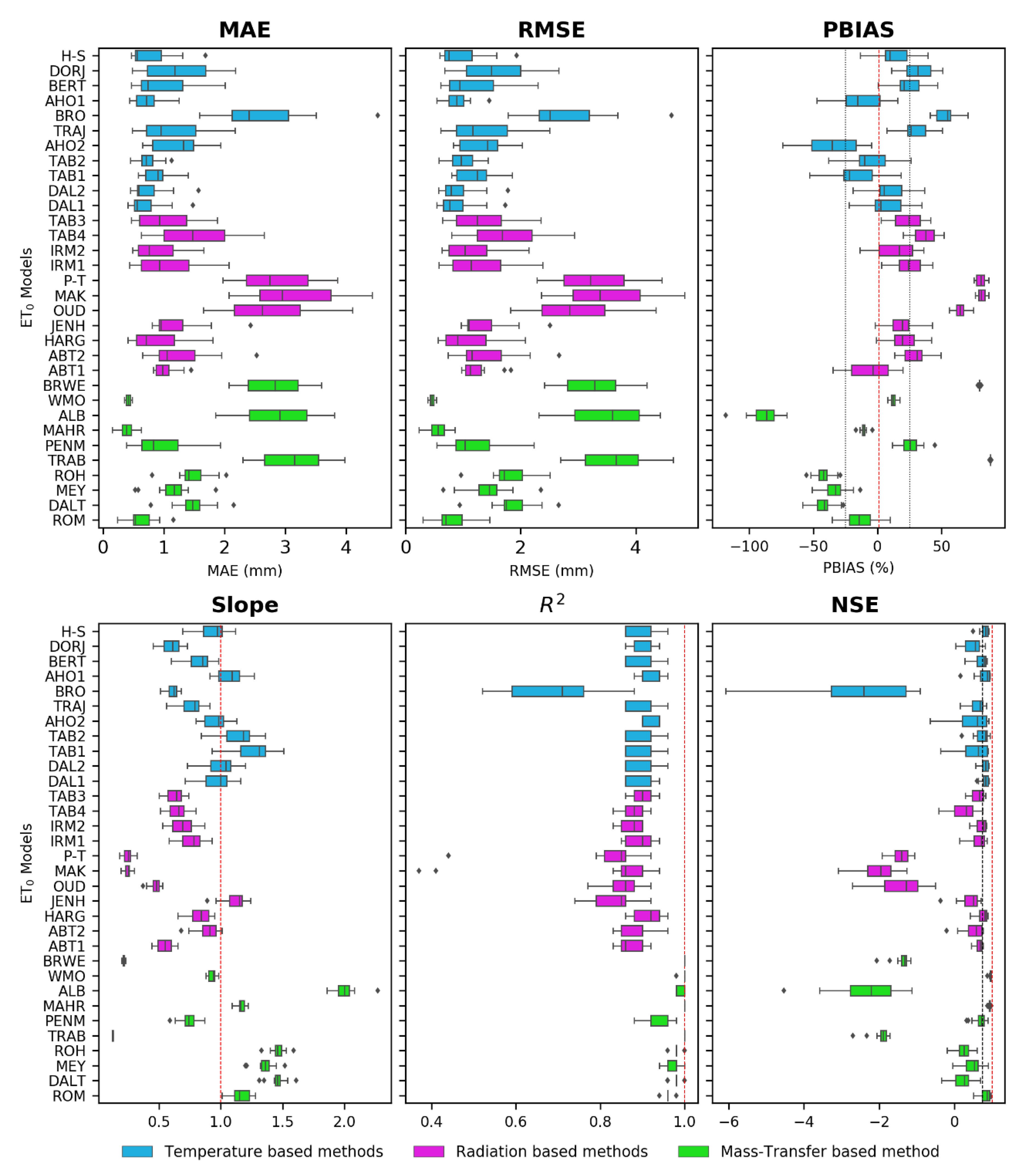
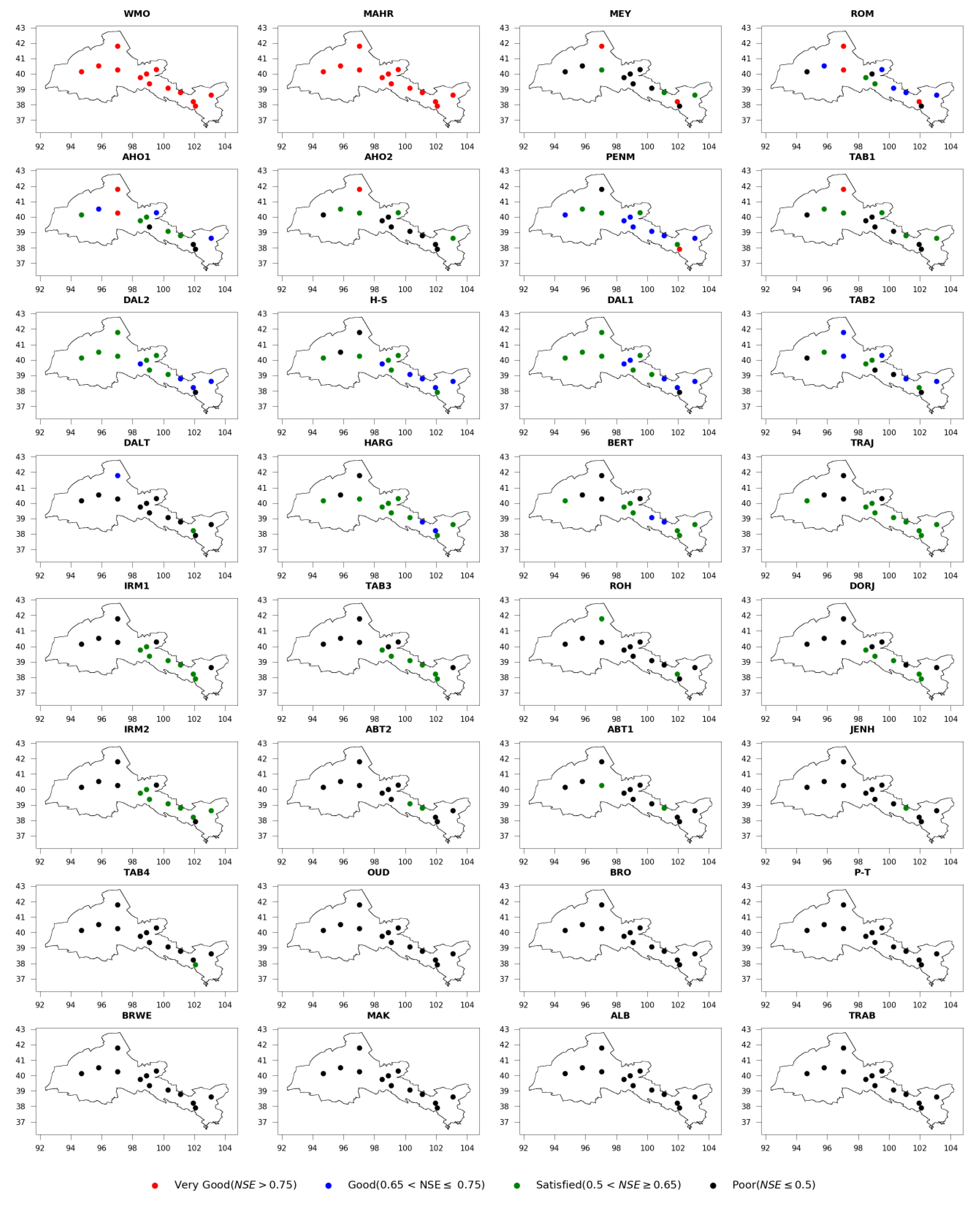
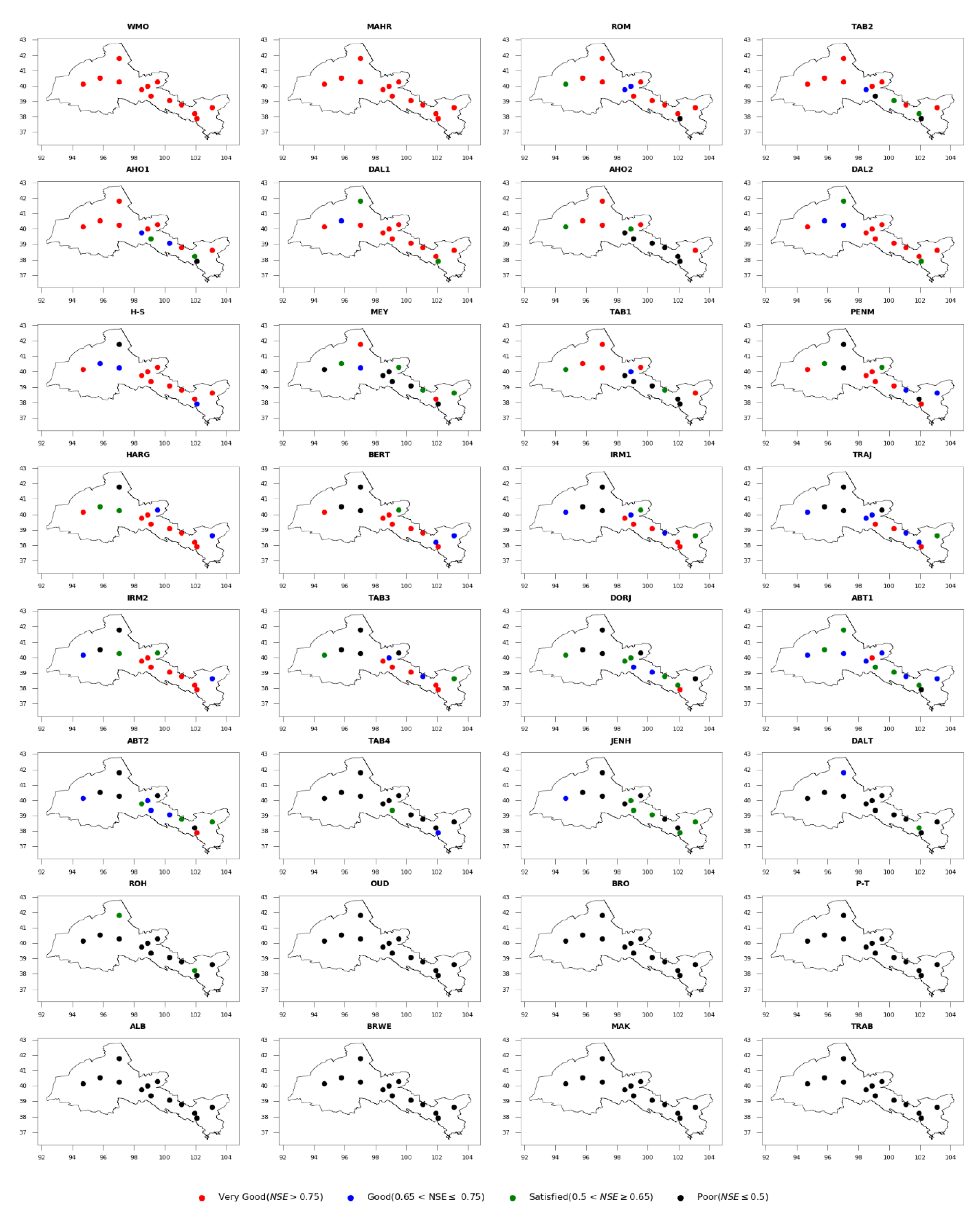
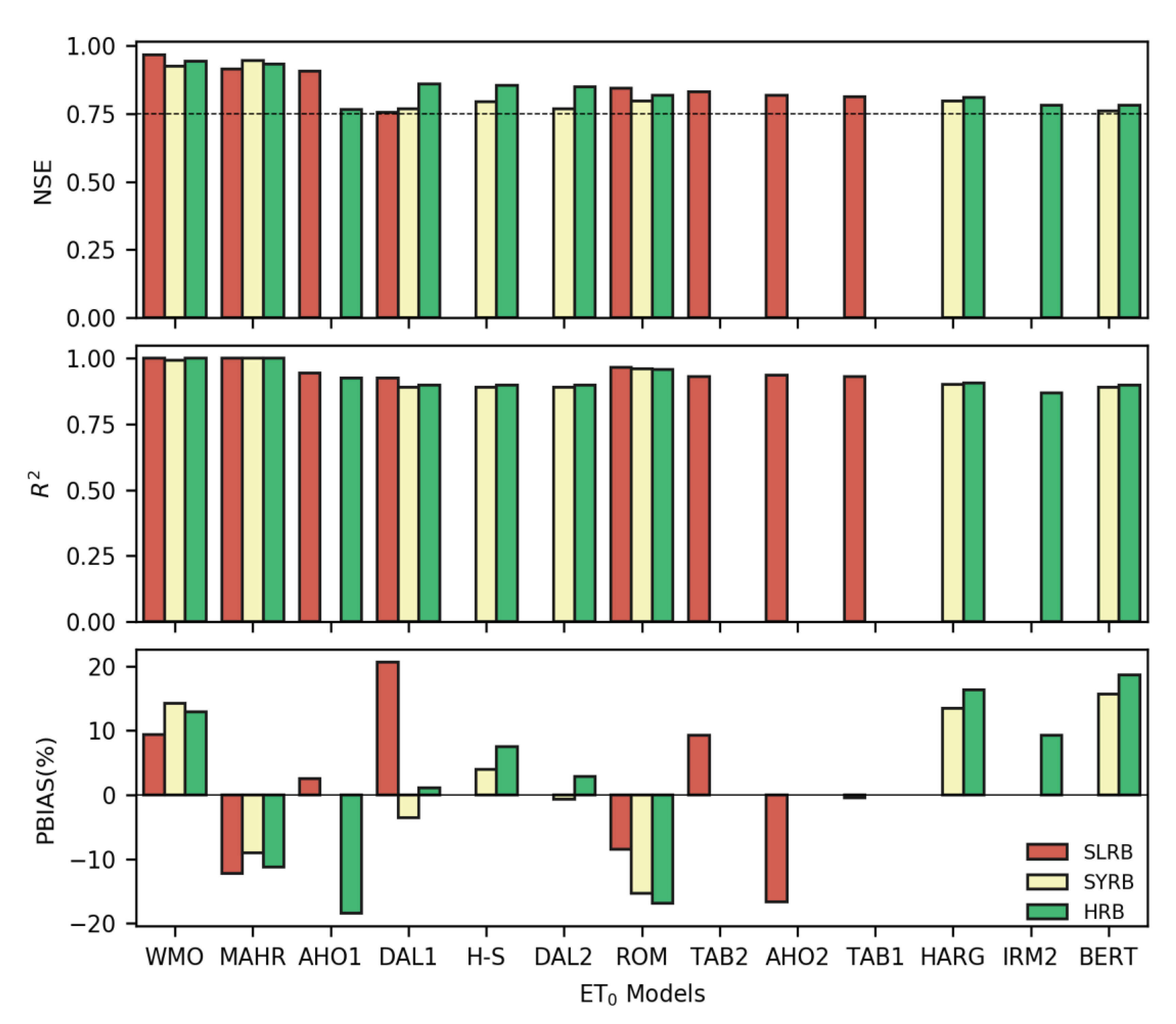
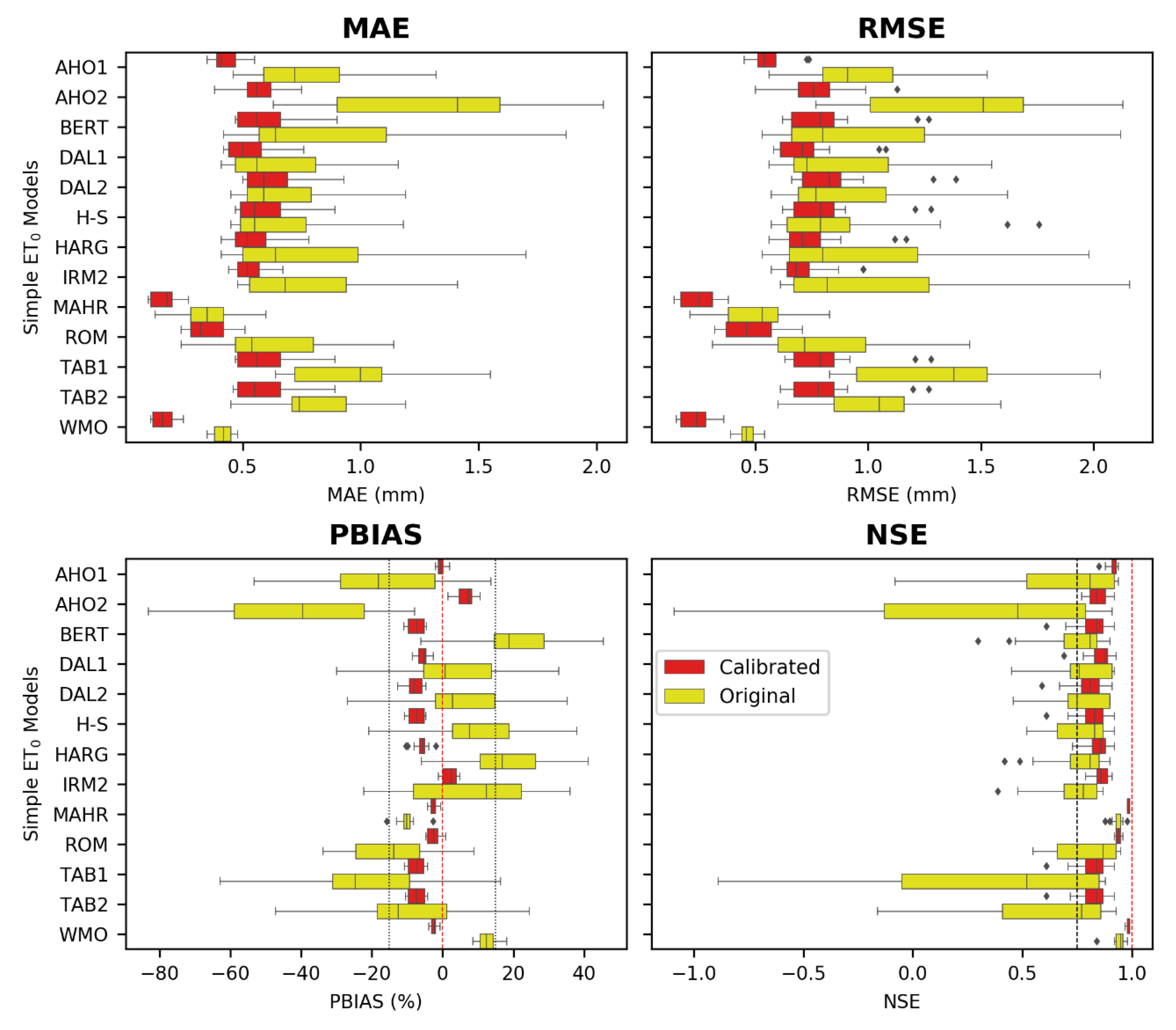

| Basin | Station | Latitude °N | Longitude °E | Elevation M | Tmean °C | Tmax °C | Tmin °C | Rhmean % | RHmax % | RHmin % | U10m m/s | SSD h | Rs MJ/m2 |
|---|---|---|---|---|---|---|---|---|---|---|---|---|---|
| SLRB | Mazongshan | 41.8 | 97.03 | 1770 | 4.53 | 12.3 | −2.4 | 39.4 | 59.67 | 19.1 | 4.47 | 9.17 | 17.36 |
| Dunhuang | 40.2 | 94.68 | 1139 | 9.79 | 18.18 | 2.16 | 42.2 | 63.53 | 20.4 | 2.02 | 8.94 | 17.51 | |
| Guazhou | 40.5 | 95.78 | 1171 | 9.09 | 17.62 | 1.82 | 40.3 | 59.52 | 21.5 | 3.03 | 8.71 | 17.13 | |
| Yumenzhen | 40.3 | 97.03 | 1526 | 7.28 | 14.79 | 0.47 | 42.2 | 61.73 | 22.4 | 3.59 | 8.83 | 17.3 | |
| HRB | Dingxin | 40.3 | 99.52 | 1177 | 8.53 | 16.65 | 1.36 | 43 | 67.01 | 21.4 | 3.07 | 9.12 | 17.62 |
| Jinta | 40 | 98.88 | 1271 | 8.56 | 16.46 | 1.34 | 44 | 65.69 | 22.4 | 2.52 | 8.96 | 17.49 | |
| Jiuquan | 39.8 | 98.48 | 1477 | 7.61 | 15.02 | 1.19 | 47 | 68.32 | 25.3 | 2.23 | 8.42 | 16.89 | |
| Gaotai | 39.4 | 99.08 | 1332 | 7.99 | 16.14 | 1.15 | 52.8 | 79.85 | 25.4 | 2.05 | 8.49 | 17.06 | |
| Zhangye | 39.1 | 100.3 | 1461 | 7.57 | 15.95 | 0.6 | 51.2 | 77.02 | 24.7 | 2.13 | 8.45 | 17.08 | |
| Shangdan | 38.8 | 101.1 | 1766 | 6.71 | 14.83 | 0.04 | 46.9 | 68.43 | 23.9 | 2.37 | 7.98 | 16.53 | |
| SYRB | Yongchang | 38.2 | 101.9 | 2094 | 5.27 | 12.75 | −1.0 | 51.6 | 75.01 | 27.5 | 2.93 | 8.13 | 16.76 |
| Wuwei | 37.9 | 102.1 | 1532 | 8.37 | 15.65 | 1.96 | 51.1 | 73.95 | 26.3 | 1.76 | 7.95 | 16.64 | |
| Minqin | 38.6 | 103.1 | 1368 | 8.56 | 16.26 | 1.66 | 44.3 | 65.53 | 22.1 | 2.64 | 8.49 | 17.19 |
| No | Authors/Models | Abbreviation | Methods/Formulation | Latitude | Elevation | Tmean | Tmax | Tmin | RHmean | RHmax | RHmin | U2m | Rs |
|---|---|---|---|---|---|---|---|---|---|---|---|---|---|
| Combination-based methods | |||||||||||||
| (1) | Penman–Monteith [12] | FAO56 | ✓ | ✓ | ✓ | ✓ | ✓ | ✓ | ✓ | ✓ | ✓ | ✓ | |
| Temperature-based methods | |||||||||||||
| (2) | Hargreaves and Samani (1985) [54] | H-S | ✓ | ✓ | ✓ | ✓ | |||||||
| (3) | Trajkovic (2007) [21] | TRAJ | ✓ | ✓ | ✓ | ✓ | |||||||
| (4) | Tabari and Talaee-1 (2011) [18] | TAB1 | ✓ | ✓ | ✓ | ✓ | |||||||
| (5) | Tabari and Talaee-2 (2011) [18] | TAB2 | ✓ | ✓ | ✓ | ✓ | |||||||
| (6) | Droogers and Allen-1 (2002) [20] | DAL1 | ✓ | ✓ | ✓ | ✓ | |||||||
| (7) | Droogers and Allen-2 (2002) [20] | DAL2 | ✓ | ✓ | ✓ | ✓ | |||||||
| (8) | Berti et al. (2014) [6] | BERT | ✓ | ✓ | ✓ | ✓ | |||||||
| (9) | Dorji et al. (2016) [19] | DORJ | ✓ | ✓ | ✓ | ✓ | |||||||
| (10) | Baier and Robertson (1965) [65] | BRO | ✓ | ✓ | ✓ | ||||||||
| (11) | Ahooghalandari-1 (2016) [7] | AHO1 | ✓ | ✓ | ✓ | ||||||||
| (12) | Ahooghalaandari-2 (2016) [7] | AHO2 | ✓ | ✓ | ✓ | ||||||||
| Solar radiation- based methods | |||||||||||||
| (13) | Makkink (1957) [44] | MAK | ✓ | ✓ | ✓ | ||||||||
| (14) | Priestley and Tayler (1972) [10] | P-T | ✓ | ✓ | ✓ | ||||||||
| (15) | Jensen and Haise(1963) [55] | JENH | ✓ | ✓ | |||||||||
| (16) | Hargreaves (1975) [57] | HARG | ✓ | ✓ | |||||||||
| (17) | Abtew-1(1996) [58] | ABT1 | ✓ | ✓ | |||||||||
| (18) | Abtew-2(1996) [58] | ABT2 | ✓ | ✓ | |||||||||
| (19) | Irmak et al. (2003)-1 [59] | IRM1 | ✓ | ✓ | |||||||||
| (20) | Irmak et al. (2003)-2 [59] | IRM2 | ✓ | ✓ | |||||||||
| (21) | Tabari and Talaee (2011) [18] | TAB3 | ✓ | ✓ | |||||||||
| (22) | Tabari and Talaee (2011) [18] | TAB4 | ✓ | ✓ | ✓ | ||||||||
| (23) | Oudin (2004) [65] | OUD | ✓ | ✓ | |||||||||
| Mass transfer-based methods | |||||||||||||
| (24) | Dalton (1802) [63] | DALT | ✓ | ✓ | ✓ | ✓ | ✓ | ||||||
| (25) | Meyer (1926) [66] | MEY | ✓ | ✓ | ✓ | ✓ | ✓ | ||||||
| (26) | Rohwer (1931) [60] | ROH | ✓ | ✓ | ✓ | ✓ | ✓ | ||||||
| (27) | Albrecht (1950) [67] | ALB | ✓ | ✓ | ✓ | ✓ | ✓ | ||||||
| (28) | WMO (1966) [68] | WMO | ✓ | ✓ | ✓ | ✓ | ✓ | ||||||
| (29) | Trabert (1896) [69] | TRAB | ✓ | ✓ | ✓ | ✓ | ✓ | ||||||
| (30) | Brockamp and Wenner (1963) [70] | BRWE | ✓ | ✓ | ✓ | ✓ | ✓ | ||||||
| (31) | Mahringer (1970) [61] | MAHR | ✓ | ✓ | ✓ | ✓ | ✓ | ||||||
| (32) | Penman (1948) [71] | PENM | ✓ | ✓ | ✓ | ✓ | ✓ | ||||||
| (33) | Romanenko (1961) [43] | ROM | ✓ | ✓ |
Publisher’s Note: MDPI stays neutral with regard to jurisdictional claims in published maps and institutional affiliations. |
© 2020 by the authors. Licensee MDPI, Basel, Switzerland. This article is an open access article distributed under the terms and conditions of the Creative Commons Attribution (CC BY) license (http://creativecommons.org/licenses/by/4.0/).
Share and Cite
Celestin, S.; Qi, F.; Li, R.; Yu, T.; Cheng, W. Evaluation of 32 Simple Equations against the Penman–Monteith Method to Estimate the Reference Evapotranspiration in the Hexi Corridor, Northwest China. Water 2020, 12, 2772. https://doi.org/10.3390/w12102772
Celestin S, Qi F, Li R, Yu T, Cheng W. Evaluation of 32 Simple Equations against the Penman–Monteith Method to Estimate the Reference Evapotranspiration in the Hexi Corridor, Northwest China. Water. 2020; 12(10):2772. https://doi.org/10.3390/w12102772
Chicago/Turabian StyleCelestin, Sindikubwabo, Feng Qi, Ruolin Li, Tengfei Yu, and Wenju Cheng. 2020. "Evaluation of 32 Simple Equations against the Penman–Monteith Method to Estimate the Reference Evapotranspiration in the Hexi Corridor, Northwest China" Water 12, no. 10: 2772. https://doi.org/10.3390/w12102772
APA StyleCelestin, S., Qi, F., Li, R., Yu, T., & Cheng, W. (2020). Evaluation of 32 Simple Equations against the Penman–Monteith Method to Estimate the Reference Evapotranspiration in the Hexi Corridor, Northwest China. Water, 12(10), 2772. https://doi.org/10.3390/w12102772






